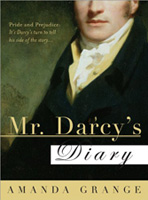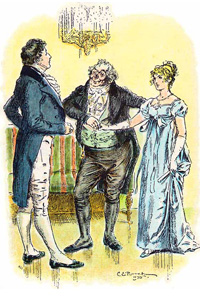By Abby Kurzman
Oh, La! Mr. Darcy Tells Us How Nice He Is
![]() I wish I’d thought of it first. Take Pride and Prejudice, one of the best novels ever written, and tell it from Mr. Darcy’s point of view. That’s the enticing formula Amanda Grange uses in Mr. Darcy’s Diary. At Lucas Lodge, for example, when Elizabeth turns down Darcy’s offer to dance, he thinks:
I wish I’d thought of it first. Take Pride and Prejudice, one of the best novels ever written, and tell it from Mr. Darcy’s point of view. That’s the enticing formula Amanda Grange uses in Mr. Darcy’s Diary. At Lucas Lodge, for example, when Elizabeth turns down Darcy’s offer to dance, he thinks:
Why had she refused me? Because she had overheard me saying she wasn’t handsome enough to tempt me at the Meryton Ball? Of course! I found myself admiring her spirit. My ten thousand pounds a year meant nothing to her when compared to her desire to be revenged on me.
I admit I was skeptical when I picked the book up. Prejudiced, even. But, like most Austen enthusiasts, I’m also a romantic—which means, on occasion, I’m a sucker for a chick book like this one. Despite the book’s flaws, I must confess that I enjoyed it thoroughly.
 Mr. Darcy’s Diary transports readers to early nineteenth-century England and beguiles with the softer side of our hero, Fitzwilliam Darcy. Great literature it’s not. It’s a beach read with the requisite happy ending.
Mr. Darcy’s Diary transports readers to early nineteenth-century England and beguiles with the softer side of our hero, Fitzwilliam Darcy. Great literature it’s not. It’s a beach read with the requisite happy ending.
Amanda Grange, a popular historical romance writer in the U.K., has written 20-plus Austenesque novels in the last 10 years, including Mr. Darcy, Vampyre; Captain Wentworth’s Diary (based on Persuasion); and Wickham’s Diary (also from Pride and Prejudice). Her most recent, Henry Tilney’s Diary (from Northanger Abbey), was released in May 2011.
For the first 298 pages of Mr. Darcy’s Diary, the plot, characters, and, well, almost everything else are pilfered from Jane Austen. Whole speeches from Pride and Prejudice appear word for word; in between, the prose is simplified. It’s like reading a CliffsNotes version of the classic.
For example, on running into George Wickham en route to Meryton, Grange’s Darcy explains the reason for their strained relations in a sentence (“That odious man, who betrayed my father’s belief in him and almost ruined my sister!”), rather than letting the mystery unfold slowly, as in Austen’s version.
Such oversimplification does not impress me. Rather, I’m interested in the new window Grange provides on Darcy’s innermost thoughts, making him more transparent and sympathetic, if far less complex.
What’s going on behind that handsome face might surprise you, but I doubt it. Austen wrote satire. Grange does not. She occasionally ventures outside the lines of Darcy’s established character to ridiculous effect:
[Elizabeth] ran off gaily, like a child…. As I [Darcy] watched her run, I felt my spirits lift. I felt as though I, too, was suddenly free, free of the trammeled dignity of my life, and I longed to run after her.
 Austen must have been front and center when my writing teacher advised, “Show, don’t tell.” A turn of the head, or a glance, speaks volumes. Grange turns down the volume by telling us what’s going on, flat out. Instead of Austen hinting at the mysterious mood behind Darcy’s darkened expression, Grange writes, “She almost tempted me to smile. But I schooled my countenance into an expression of severity and turned away.“
Austen must have been front and center when my writing teacher advised, “Show, don’t tell.” A turn of the head, or a glance, speaks volumes. Grange turns down the volume by telling us what’s going on, flat out. Instead of Austen hinting at the mysterious mood behind Darcy’s darkened expression, Grange writes, “She almost tempted me to smile. But I schooled my countenance into an expression of severity and turned away.“
To me, one of the joys of reading is the freedom to develop and embellish characters in your own imagination. In Mr. Darcy’s Diary, Grange does the work for you. In fact, this is the extent of the work she’s done here, other than a burst of creative plotting at the end involving a Christmas gathering with Lady Catherine—an unlikely event, given that Lady Catherine has disowned Darcy and is known for her pride and her stubbornness.
Still, despite the limits and inconsistencies of this book, some juicy stuff gets more play—which is what makes Mr. Darcy’s Diary a good read even for us P&P sticklers.
By expanding the story to include the honeymoon and the settling-in period at Darcy’s estate, Pemberley, Grange is able to add some tasteful sexual innuendo (she’s a romance novelist, remember). When Darcy shows Elizabeth her suite of rooms at Pemberley, which have been redecorated to her tastes, the following conversation ensues:
Do you like it?” she asked, looking round at the room again.
'It does not matter if I like it or not.'
'I think it does,” she teased me. “After all, you will be a frequent visitor.'
Here, in the added scenes, is where Grange indulges her own whims. Anne DeBourgh, Kitty, Mary—even Lady Catherine—emerge as more tolerable, and tolerant, versions of themselves.
We rejoice to learn that, indeed, Mr. Darcy loves Elizabeth for the same reasons we do: her wit, humor, and, as he puts it, sauciness:
Talking to Elizabeth is like talking to no one else. It is not a commonplace activity; rather it is a stimulating exercise for the mind.
Most of all, I appreciated the true, human feelings Grange’s characters reveal, while Austen’s hide their impulses behind their manners. Notes Darcy at one point:
Sir William…tormented me with a long conversation on the subject of dancing, asking me if I had ever danced at St. James’s. I thought if he mentioned St. James’s once more, I should be tempted to strangle him with his own garter.
Who can blame Mr. Darcy? I laughed out loud.
Publishing Information:
- Mr. Darcy’s Diary by Amanda Grange (Sourcebooks, 2007)
Art Information
- "Mr. Darcy, you must allow me to present this young lady to you as a very desirable partner," C. E. Brock illustration for the 1895 edition of Jane Austen's novel Pride and Prejudice (Chapter 6); public domain
Abby Kurzman spent fifteen years as a copywriter in the travel industry and has visited Australia, China, Montenegro, Croatia, the Republic of Kiribati, and Will and Kate’s favorite: Wales. She is currently pursuing a master’s in journalism at Harvard University Extension School and volunteering as a writing tutor with 826 Boston.
Kurzman lives in Brookline, where she is the proud owner of a primo parking space.
This summer, she's taking a course in grant proposal writing, looking forward to spending time at the beach with her nieces and nephews, and seeking new adventures close to home (such as investigating the mystery of the lost socks—especially the one from Sydney with the koalas on it).

